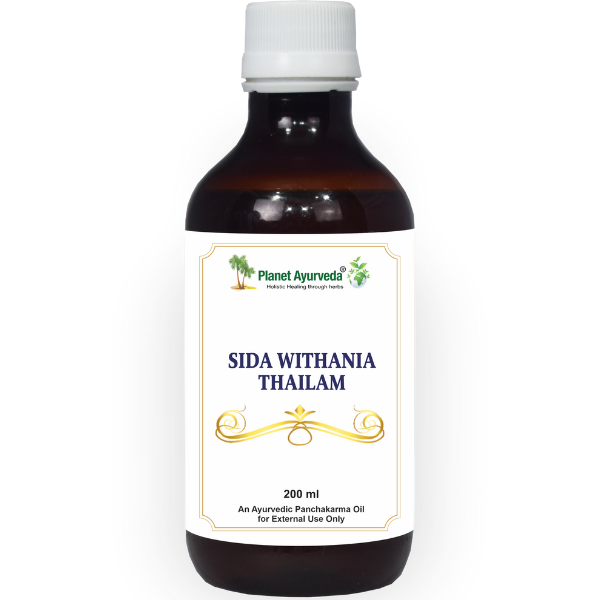Sida Withania Thailam – Key Ingredients, Their Benefits, Indications & Panchakarma Uses
Classical Reference : Bala Ashwagandha Thailam
Introduction
Sida Withania Thailam by Planet Ayurveda is an Ayurvedic oil formulated with powerful herbs like Sida cordifolia (Bala), Withania somnifera (Ashwagandha), and many more, renowned for their rejuvenating and strengthening properties. Its reference has been taken from Bala Ashwagandha Thailam. This medicated oil is highly effective in the management of paralysis, muscular weakness, muscle wasting, and insomnia, where Vata imbalance plays a major role. Its nourishing and revitalising action helps restore nerve function, improve muscle tone, and support overall strength. Regular massage with this oil calms the nervous system, promotes deep relaxation, and enhances sleep quality. By pacifying aggravated Vata, Sida Withania Thailam supports mobility, vitality, and neurological balance. It is a holistic choice for those seeking natural recovery and strength through Ayurveda.
Ingredients With Description
1. Rasna (Pluchea lanceolata)
Rasna contains active phytochemicals such as moretenol, neolupenol, stigmasterol, beta-sitosterol-D-glucoside, quercetin, and isorhamnetin, which exhibit strong anti-inflammatory, antioxidant, and analgesic properties. These bioactive compounds help reduce joint pain, stiffness, and nerve inflammation, making Rasna beneficial in conditions like paralysis and spondylosis. By pacifying aggravated Vata dosha, Rasna enhances mobility, supports muscle relaxation, and alleviates neuromuscular irritation.
2. Manjishtha (Rubia cordifolia)
Manjistha contains rich bioactive constituents, including anthraquinones (such as purpurin, munjistin, alizarin, and rubiadin), glycosides, tannins, flavonoids, iridoids, and triterpenoids. These compounds purify the blood, detoxify the nervous system, and improve micro-circulation. Manjistha helps prevent muscle wasting and supports recovery in paralysis and neuromuscular disorders by clearing blocked channels and enhancing nourishment to weak tissues.
3. Durva (Cynodon dactylon)
Durva (Cynodon dactylon) contains powerful bioactive compounds, including flavonoids like luteolin, apigenin, orientin, and vitexin, along with phenolic compounds such as hydroquinone, ferulic acid, and syringic acid. These exhibit strong antioxidant, neuroprotective, and CNS-calming properties. By soothing the nervous system, enhancing sleep quality in insomnia, and supporting tissue repair, Durva helps improve muscular strength and overall neurological health.
4. Madhuka (Madhuca indica)
Madhuka contains key bioactive compounds such as Madhucosides A and B, Misaponin A and B, triterpenoids including alpha- and beta-amyrin, lupeol acetate, betulinic acid, oleanolic acid, and flavonoids like quercetin, myricetin, kaempferol, and gallic acid. These phytochemicals offer strong muscle and nerve-nourishing effects, helping reduce tissue degeneration and improve neuromuscular strength. Madhuka supports better sleep, enhances the restoration of weak muscles, and contributes to overall neurological wellbeing by calming aggravated Vata.
5. Chora (Kachora – Angelica glauca)
The active constituents of this herb include essential oils, flavonoids, coumarins, phthalides, and various mono- and sesquiterpenes. These compounds act as powerful nervine tonics, improving blood circulation and supporting nerve regeneration. By reducing stiffness and enhancing muscle function, they are particularly beneficial in paralysis and neuromuscular disorders. It helps in restoring mobility and overall nervous system health through effective Vata-balancing action.
6. Sariva (Hemidesmus indicus)
Sariva contains important bioactive compounds such as triterpenoids (lupeol, α- and β-amyrin, 3-keto-lup-12-en-21→28-olide), steroids and glycosides (Hemidesmin I & II, β-sitosterol, indicine, hemidine, pregnane oligoglycosides), and flavonoids like rutin and hyperoside. These constituents provide antioxidant, adaptogenic, and calming effects that help strengthen the nervous system and improve muscle tone. Sariva supports neuromuscular health and enhances recovery in Vata-related disorders by reducing stress-induced insomnia and pacifying aggravated Vata.
7. Ushir (Vetiveria zizanioides)
The essential oils like vetiverol and khusimol in Ushir possess sedative and cooling properties. These compounds relax the nervous system, promote sound sleep, and prevent neuro-muscular wasting caused by excessive Vata activity.
8. Mustak (Cyperus rotundus)
Mustak contains sesquiterpenes and essential oils, which improve circulation, reduce inflammation, and calm the nervous system. These bioactive compounds strengthen weak muscles and help manage insomnia by pacifying aggravated Vata.
9. Devdaru (Cedrus deodara)
The bioactive constituents like sesquiterpenes, himachalene, and cedrol act as anti-inflammatory and nervine relaxants. These chemicals help reduce muscle stiffness, improve nerve conduction, and support recovery in paralysis and Vata aggravation.
10. Haridra (Curcuma longa)
Haridra contains curcumin, a potent anti-inflammatory and antioxidant compound. Curcumin supports nerve repair, reduces oxidative damage in paralysis, strengthens muscles, and helps regulate neurotransmitters to improve insomnia.
11. Kumuda (Nymphaea alba)
Kumuda contains beneficial alkaloids such as nupharine, nymphaeine, and nupharidine, along with flavonoids like quercetin, kaempferol, apigenin, isokaempferide, luteolin and their various glycosides. These bioactive compounds exhibit sedative, cooling, and neuro-calming properties that help reduce nervous system hyperactivity. By promoting relaxation, improving sleep quality, and supporting muscle recovery, Kumuda is effective in managing Vata-related neurological disturbances.
12. Renuka (Vitex agnus-castus)
Renuka contains key bioactive compounds, including flavonoids (vitexin, isovitexin, casticin, orientin, isoorientin, luteolin), iridoid glycosides (agnuside, aucubin), and diterpenoids (vitexilactone, rotundifuran). These constituents help regulate neurotransmitters such as dopamine and serotonin, promoting mental relaxation and improving sleep quality. Renuka aids recovery in paralysis, reduces muscle wasting, and effectively balances aggravated Vata by calming the nervous system and supporting neuromuscular function.
13. Shathahwa (Anethum sowa)
The presence of carvone, limonene, and sulphated flavonoids in Shathahwa improves digestion and nerve nourishment. These bioactive compounds reduce neuromuscular weakness, promote relaxation, and calm aggravated Vata, aiding in insomnia.
14. Padmakesara (Nelumbo nucifera)
Padmakesara contains nuciferine and flavonoids (quercetin and kaempferol derivatives), which act as natural sedatives and antioxidants. These compounds calm the nervous system, improve blood circulation, and promote muscle nourishment in wasting disorders.
15. Til Tail (Sesamum indicum)
Sesame oil is rich in sesamin, sesamol, and vitamin E, which are powerful antioxidants and tissue rejuvenators. These compounds reduce oxidative stress, strengthen nerves, nourish muscles, and pacify aggravated Vata.
16. Bala (Sida cordifolia)
Bala contains ephedrine alkaloids, phytosterols, and flavonoids (Quercetin derivatives, kaempferol derivatives, and several isoprenyl flavones), which enhance nerve conduction and muscle strength. These chemicals restore function in paralysis, prevent wasting, and provide energy while balancing Vata.
17. Ashwagandha (Withania somnifera)
Ashwagandha is rich in withanolides, steroidal lactones and saponins, known for their adaptogenic and neuroprotective properties. These compounds promote nerve regeneration, improve muscle tone, reduce stress-induced insomnia, and pacify aggravated Vata.
18. Dadhi Mastu (Curd Supernatant Liquid)
It contains probiotics, lactic acid, and enzymes, which improve digestion and nutrient assimilation. Better nourishment ensures strength in muscles.
Benefits
- Balances Vata Dosha
- Relieves Muscle & Joint Discomfort
- Helps Support General Vitality
- Improves Skin Condition & Nourishes Tissues
- Effective in Weakness and Tiredness
- Promotes Relaxation and Comfort
- Promotes Healthy Sleep
Ideal For (Indications)
- Joint Stiffness
- Muscular Weakness, Wasting, or Spasm
- Nervous System Weakness
- Musculoskeletal Weakness
- Paralysis
- Insomnia
- Vataj Disorders
Panchakarma Uses
Sida Withania Oil is a rejuvenative Ayurvedic formulation widely used in Panchakarma therapies. Here are some of the Panchakarma therapies in which this oil is used:
1. Abhyanga (Oil Massage)
Abhyanga with Sida Withania Oil is highly beneficial in muscular weakness, paralysis, and general wasting conditions. The warm oil penetrates deeply, nourishes tissues, and strengthens muscles. It balances aggravated Vata, improves circulation, and helps restore vitality to weak or wasted areas. For better results, it can be given in combination with Dhanwantharam Oil.
2. Janu Basti (Knee Therapy)
In paralysis or muscle wasting affecting the legs, Janu Basti with Sida Withania Oil provides localised nourishment to the knee joints and surrounding muscles. The retained warm oil reduces stiffness, strengthens weakened tissues, and supports better mobility. It also alleviates Vata-induced pain and dryness.
3. Kati Basti (Lower Back Therapy)
Kati Basti with Sida Withania Oil is excellent for paralysis and muscular wasting involving the lower back and limbs. By retaining warm oil over the lumbar region, it relieves stiffness, strengthens nerves, and enhances spinal support. It is especially beneficial in Vata aggravation-related lower-body weakness.
4. Anuvasan Basti (Oil Enema)
Anuvasan Basti with Sida Withania Oil provides deep nourishment and balances aggravated Vata at its root. It is highly effective in paralysis, muscle wasting, and neurological weakness. The oil strengthens nerves, improves bowel function, and restores vitality in chronic Vata disorders.
5. Griva Basti (Neck Therapy)
Griva Basti using Sida Withania Oil benefits patients with cervical muscle weakness, paralysis, or stiffness due to Vata aggravation. The retained warm oil strengthens the cervical spine, improves flexibility, and nourishes wasted muscles. It also reduces pain and supports recovery from neurological weakness.
Note Sida Withania Oil can be given in combination with Mahanarayan Oil in all types of Basti for effective results.
To buy Sida Withania Oil, please visit store.planetayurveda.com/products/sida-withania-thailam
Conclusion
Sida Withania Oil, enriched with the strength of Bala, Ashwagandha and many more, serves as a potent Vata-pacifying formulation in Panchakarma therapies. Its nourishing, strengthening, and rejuvenative qualities make it highly effective in managing paralysis, muscular weakness, wasting, and insomnia. Through therapies like Abhyanga, Basti, and Shirodhara, it not only restores vitality to weakened tissues but also calms the nervous system and enhances overall well-being. Thus, Sida Withania Oil stands as a valuable remedy for both curative and preventive care in Vata disorders.




